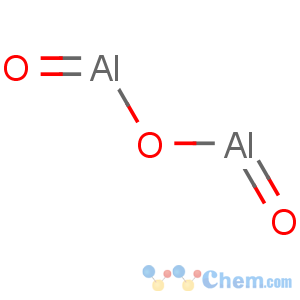Title: Aluminum Oxide
CAS Registry Number: 1344-28-1
Synonyms: Alumina
Molecular Formula: Al2O3
Molecular Weight: 101.96
Percent Composition: Al 52.93%, O 47.08%
Literature References: Occurs in nature as the minerals:
bauxite,
bayerite,
boehmite,
corundum,
diaspore,
gibbsite. Prepn and properties:
Mellor's vol. V, 263-273 (1929);
Gmelins, Aluminum (8th ed.)
35B, pp 7-98 (1934); Becher in
Handbook of Preparative Inorganic Chemistry vol. 1, G. Brauer, Ed. (Academic Press, New York, 2nd ed., 1963) pp 822-823; Wagner,
ibid. vol. 2 (1965) pp 1660-1663. Use as column matrix in ion chromatography: W. Buchberger, K. Winsauer,
J. Chromatogr. 482, 401 (1989); in HPLC: M. T. Kelly, M. R. Smyth,
J. Pharm. Biomed. Anal. 7, 1757 (1989). Clinical evaluation in hip replacement: L. Sedel
et al., J. Bone Joint Surg. Br. 72-B, 658 (1990); of wear in hip replacement: L. P. Zichner, H.-G. Willert,
Clin. Orthop. Relat. Res. 282, 86 (1992). Review of properties, biocompatibility and clinical use: P. Boutin
et al., J. Biomed. Mater. Res. 22, 1203-1232 (1988); of biocompatibility: P. S. Christel,
Clin. Orthop. Relat. Res. 282, 10-18 (1992).
Properties: Approximate characteristics of native aluminum oxide: White cryst powder. Very hard, about 8.8 on Moh's scale. An electrical insulator; electrical resistivity at 300° about 1.2 ′ 1013 ohms-cm. When heated above 800° it becomes insol in acid and specific gravity increases from 2.8 to 4.0. Insol in water. Very hygroscopic.
CAUTION: Potential symptoms of overexposure by direct contact are irritation of eyes, skin and respiratory system.
See NIOSH Pocket Guide to Chemical Hazards (DHHS/NIOSH 97-140, 1997) p 12.
Use: As adsorbent, desiccant, abrasive; as filler for paints and varnishes; in manuf of alloys, ceramic materials, electrical insulators and resistors, dental cements, glass, steel, artificial gems; in coatings for metals, etc.; as catalyst for organic reactions. As a chromotagraphic matrix; originally called
Brockmann aluminum oxide when used for this purpose. The minerals
corundum (hardness = 9) and
Alundum (obtained by fusing bauxite in an electric furnace) are used as abrasives and polishes; in manuf of refractories.

